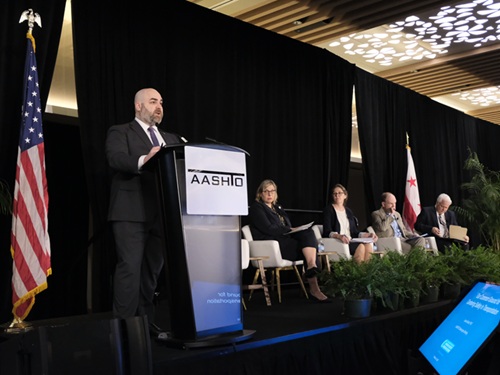A session at the American Association of State Highway and Transportation Officials 2025 Washington Briefing delved into ways to further prioritize safety for transportation workers, system users, and U.S. communities as whole.
[Above photo by AASHTO]
Moderated by Garrett Eucalitto, commissioner of the Connecticut Department of Transportation and AASHTO’s 2024-2025 president, the session featured insights from Kristina Boardman, secretary of the Wisconsin Department of Transportation; Dr. Laura Sandt, co-director of the University of North Carolina’s Highway Safety Research Center; Jonathan Adkins, CEO of the Governors Highway Safety Association; and Steve Kuciemba, executive director of Institute of Transportation Engineers.
Eucalitto noted in his opening remarks at the session that centering safety is an area of emphasis for his one-year term as AASHTO president.

“Most states agree that safety should be at the center of all of our actions to really improve safety for our communities, for all road users, and for our transportation workers,” he explained.
“We also want to work with others across each of our states who can contribute to help improve safety for our transportation system for everyone,” he said. “We’re focused on advancing partnerships with public, private, and civic sector partners as well as exploring promising innovative approaches and sharing best practices to center safety on all users.”
Eucalitto noted that also means taking “a hard look” at the ways infrastructure influences decisions by road users while helping identify more ways to encourage “safer choices” throughout the transportation environment.
“Centering safety really requires all of us to use the resources, talents, and influence we have individually and collectively so that people who use, rely upon, and work on our transportation systems are safe,” he stressed.
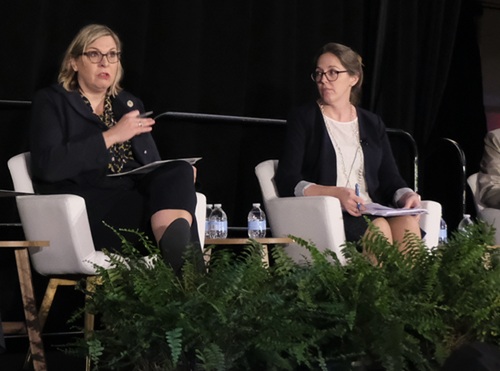
Where infrastructure is concerned, Wisconsin DOT’s Boardman pointed to the “full embrace” within her state of roundabouts as a way to improve roadway safety, especially in rural communities.
“It has been a long journey of many, many years in the making. But I’m proud to say that in Wisconsin we now have about 600 roundabouts; half on the state system, half on the local system,” she said. “Now, people did not love them from the start. But the safety stats speak for themselves. And now we have small rural communities coming to us and saying, ‘Hey, can we get a roundabout in this area?’ Because they see a difference. So I’m really proud that we have embraced this safety measure and it is making a difference throughout many communities.”
When it comes to user safety, Boardman said that education is a key part – especially where new drivers are concerned. “So how do you change behavior? I think it has to come through education,” she said.
While driver’s education is expensive and is no longer covered as a categorical aid through public schools, Boardman explained that the state stepped in with $6 million in grants to provide it for free to certain groups. “We sold out basically of those grants within the first three months,” she noted. “So there is a need out there.”
Meanwhile, Dr. Sandt stressed the important role transportation plays in the health of communities across the country. “Public health is really dependent upon transportation to get people to access the health care and the services that they need, to get folks to education, to jobs, as well as to community connections and opportunities for physical activity and health,” she said. “It is so essential for the lifeblood of our communities.”
Dr. Sandt explained that transportation safety improvements “have huge benefits” for general public health. “When people go to the emergency department, that’s just the first step in the public health treatment recovery and survival process,” she said. “Crash survivors can sustain life altering injuries, brain injuries that affect their ability to function in our society. We see rising rates of depression, mental health issues and all kinds of other health outcomes, including increased opioid use resulting from our traffic injuries. Those really are true costs that need to be reined in in a systemic way as part of a long-term focus on safety.”
That is why she believes speed management must be the “backbone” of a safe system approach in transportation.
“We cannot put our workers on the side of a road when cars are going 60 miles an hour in close proximity and think that they are safe,” Boardman said. “And what’s important is that speed management is a public health approach. It is looking at a population method to address a shared risk factor across a large population.”
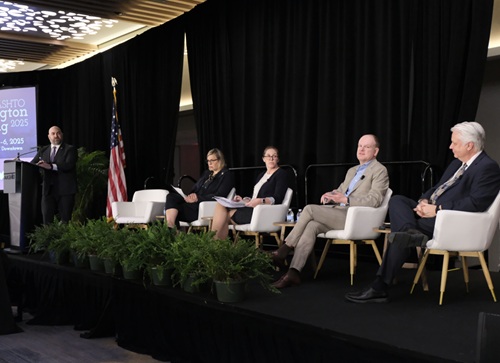
GHSA’s Adkins continued that thought by noting that there’s been a significant increase in speeding related crashes over the last few years. “And why is that? The roads didn’t suddenly become less safe as far as the infrastructure of it. The vehicles didn’t become less safe. Actually, they’re becoming safer. What changed in the last few years? It was less traffic enforcement,” he said.
Adkins stressed that “the most immediate thing that we can do” to slow drivers down and to improve safety is boost traffic enforcement. And what he described as “good” enforcement will also come about through the better use of data.
“We’re very data focused. We’re looking at long-term data trends and are really excited about the telematics and some of the new data that we’re getting and trying to understand, like how do we actually make better safety decisions based on that data?” he said. “That is really, really, really critical.”
And data is of a broader piece of the technological resources being brought to bear on transportation safety, ITE’s Kuciemba emphasized.
“It is about using evidence-based, data-driven practices and performance measures,” he explained. “Our ‘duty of care’ is about being constantly open to evaluating our standards and practices and looking at everything we do through a safety lens. Whether it’s speed limit setting or traffic control devices, it’s our ‘duty of care’ to advocate for changes that enhance safety throughout transportation.”
Kuciemba added that, with today’s technology, the industry can improve its data collection efforts to help boost safety. “Better data can give us a better understanding of near-miss events at intersections, for example,” he said. “But also help us to develop a toolbox of prevention in response to what we learn from all that the data that we can collect,” he said.
And Kuciemba stressed that it is important for the transportation industry to work together to truly extract the safety value from that data.
“We really need to work with others as much as possible,” he emphasized. “It’s the only way we’re going to reach our true goal of prioritizing roadway safety. We have to all be in the same boat, rowing in the same direction.”
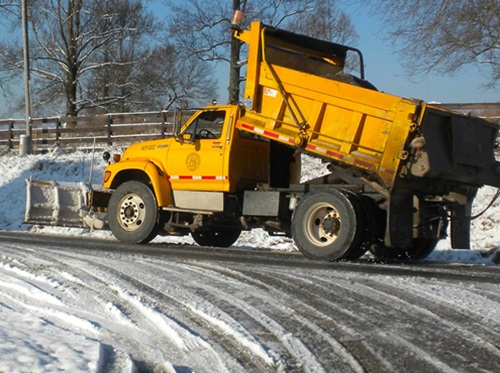 Top Stories
Top Stories
State DOTs Making Preparations for Wintertime Operations
December 12, 2025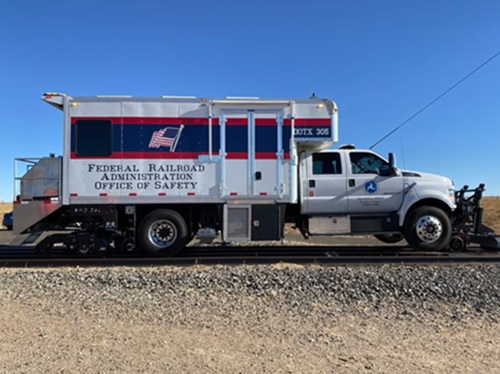 Top Stories
Top Stories
